Trees
Most of the flora and fauna intentionally planted in Hermann Park are native or adapted Texas species. In the Park there are nearly 10,000 trees, some approaching 100 years old; there are also numerous young trees added to the Hermann Park landscape each year.
Trees in cities have a multitude of benefits such as lowering high city temperatures up to nine degrees Fahrenheit, providing shade to parked cars and buildings, absorbing atmospheric pollutants to improve the air quality, and assisting the control of storm water runoff (HARC, 2004). Take a closer look at some of Hermann Park’s most popular trees as you explore, and consider planting some Texas beauty in your very own yard.
STOP 1.
Live Oak (Quercus virginiana)
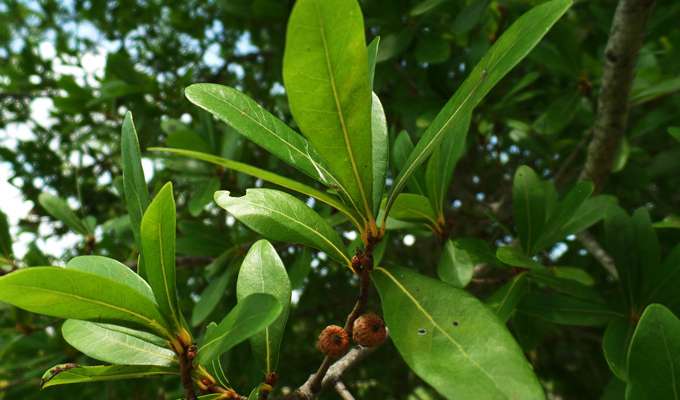
Live Oaks (Quercus virginiana) are medium to large evergreen oak trees with horizontal branching, dark brown bark, and 1” acorns. Live Oaks shed their old foliage in late winter. This is the most populous tree in the Park with a count of approximately 1,800 trees. Live Oaks are found growing along the curb lines and jogging trails in the Park.
Light Full sun
Size 40-50’ tall, 80-100’ wide
Water Medium to low
Soil Adaptable
STOP 2.
Loblolly Pine (Pinus taeda)
web.jpg)
Loblolly Pines (Pinus taeda) are medium to large trees with six to nine inch long evergreen needles that grow in bundles of three. These trees produce red-brown cones, have scaly plated bark, and a very straight trunk. There are nearly 1,400 young and mature Loblolly Pines throughout the Park. The small pine pictured is near Brays Bayou in view of the Bill Coats Bridge.
Light Full sun
Size 60-100’ tall, 25-35’ wide
Water Once established, needs moderate watering
Soil Tolerates many soils and is somewhat drought resistant
STOP 3.
Crape Myrtle (Lagerstroemia indica)
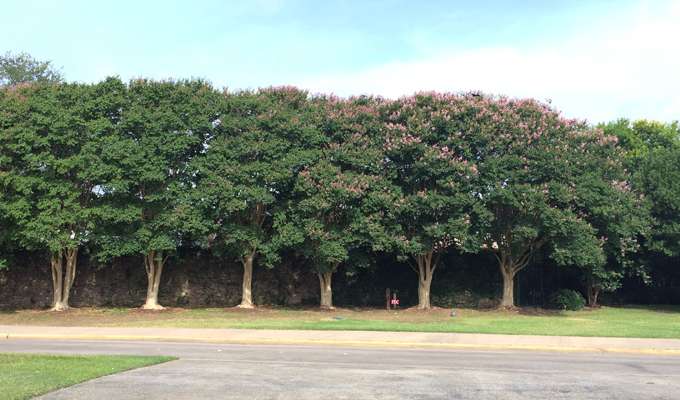
Crape Myrtles (Lagerstroemia indica) are small to medium to large sized, multi-stemmed, deciduous trees with vibrant flower clusters. The thin bark exfoliates to expose a smooth brown-grey bark underneath. Crape Myrtles are also called the “lilac of the south” because their flowers are similar to the Northern Lilac. Crape Myrtles are found scattered throughout the Park. Crapes of different sizes are located at the entrance to parking lot G and lining the Zoo fence.
Light Full sun
Size 15-30’ tall, 6-15’ wide
Water Once established, will tolerate drought
Soil Does best in moist, well drained soil, but will survive in a variety of soils
STOP 4.
Post Oak (Quercus stellata)
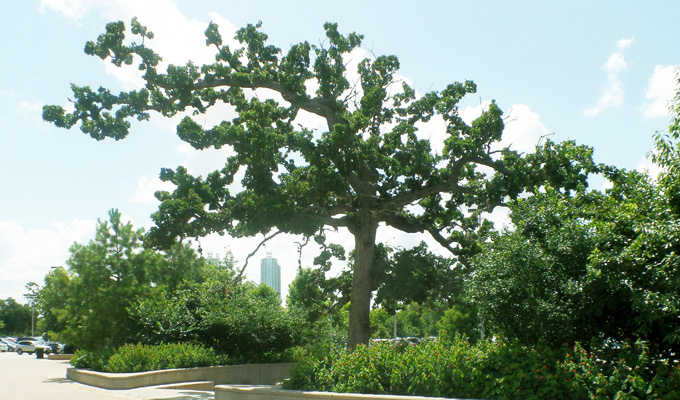
Post Oaks (Quercus stellata) are a deciduous shade tree that grows slowly, has shallow roots, and is known for its sturdy wood that is commonly used for lumber. The leaves are distinctively cross-shaped and the acorns have a bowl-shaped cup. Harris County lies near the southern boundary of where Post Oaks naturally thrive. The large Post Oak pictured here is in Lake Plaza. Some would say it resembles a giant Bonsai Tree.
Light Full sun
Size 50-80’ tall, 40-70’ wide
Water Fairly drought tolerant, but can be damaged in extreme drought as well as excessive rain
Soil Needs well-draining soil that is neutral or acidic
STOP 5.
Bald Cypress (Taxodium distichum)
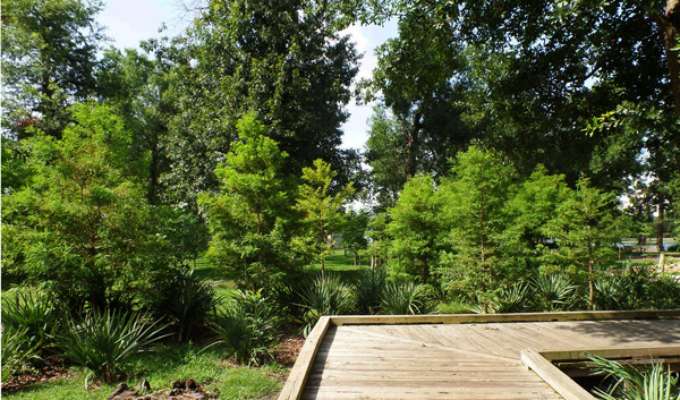
Bald Cypress trees (Taxodium distichum) are deciduous conifers that survive well in city conditions. When growing near water, the roots come to the surface to form “knees.” You will find these Bald Cypress by the boardwalk in Lake Picnic Area to the east of the Molly Ann Smith Plaza.
Light Full sun
Size 50-70’ tall, 25’ wide
Water Adaptable to wet or dry conditions
Soil Prefers moist, acid soils
STOP 6.
Willow Oak (Quercus phellos)
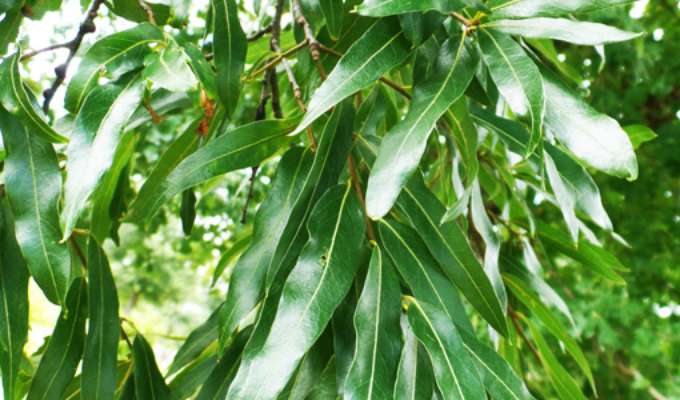
Willow Oaks (Quercus phellos) have narrow, pointy, willow-like leaves that grow in clusters. This ornamental deciduous tree has atypical soft wood for an oak and frequently grows near waterways and bottomlands. The photo of these Willow Oak leaves was taken from the mature tree that is growing alongside the parking lot F and behind Kinder Station, near the Houston B-Cycle Station.
Light Full sun
Size 40-60’ tall and 35’ wide
Water Widely adaptable
Soil Prefers acidic soil
STOP 7.
Cedar Elm (Ulmus crassilolia)
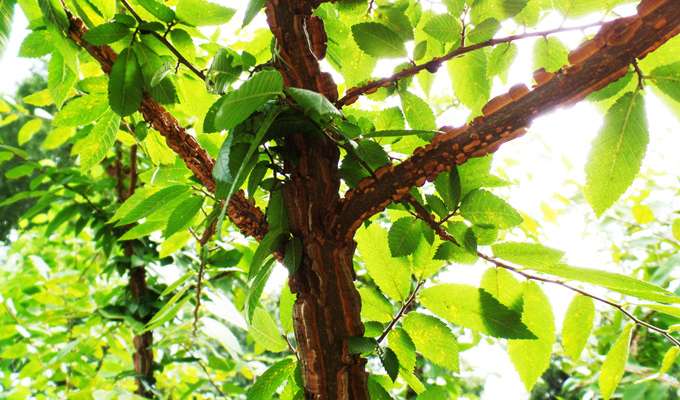
Cedar Elm (Ulmus crassilolia) leaves are small and rough on the top. When this medium to large deciduous elm tree is young, there may be corky wings on the twigs. The close-up image of Cedar Elm wings was taken near the Buddy Carruth Playground for All Children.
Light Full sun
Size 50-70’ tall, 40-60’ wide
Water Medium to low water requirements, drought tolerant
Soil Can withstand poorly drained clay soils, alkaline adaptable
STOP 8.
Red Bud (Cercis canadensis)
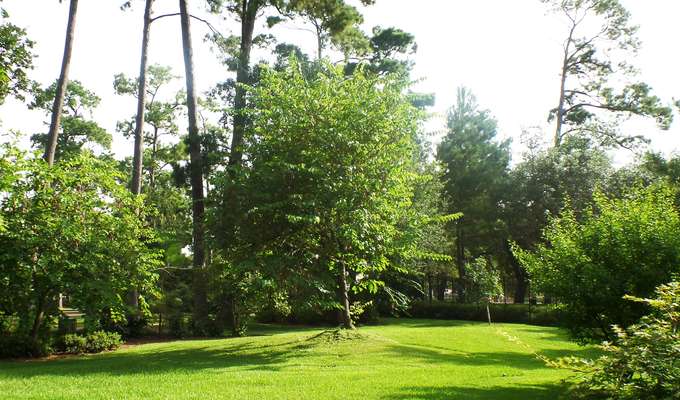
Red Buds (Cercis canadensis) are a fairly small deciduous legume with purple-pink flowers that bloom in the early spring. Red Buds have heart shaped leaves. This Red Bud tree is located inside the Japanese Garden to the right of the entrance. There are also many new Red Buds planted near the train footbridge in the “island” of McGovern Lake.
Light Full sun to shade
Size 30’ tall, 25’ wide
Water Tolerates both drought and wet soil
Soil Grows best in well drained moist soil, but does well in alkaline and clay
STOP 9.
Shumard Oak (Quercus shumardii)
web.jpg)
Shumard Oaks (Quercus shumardii) are good, medium-sized trees with a beautiful copper red fall color. Birds and squirrels love the egg-shaped acorns. The Shumard Oak pictured is near the Buddy Carruth Playground for All Children water play feature.
Light Full sun
Size 40-60’ tall, 40-60’ wide
Water Drought tolerant
Soil Prefers well-drained soil
STOP 10.
Water Oak (Quercus nigra)
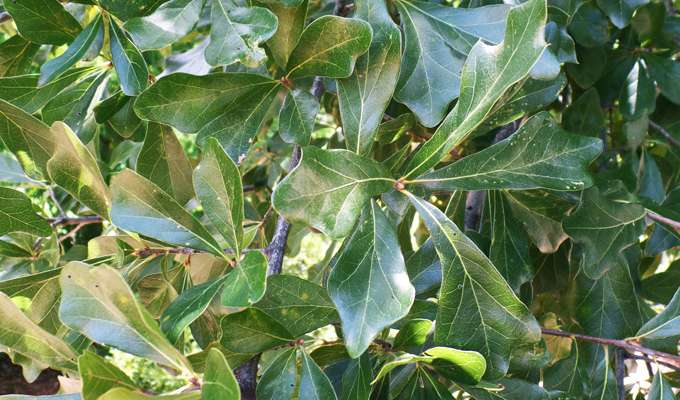
Water Oaks (Quercus nigra) are fast growing, large, deciduous oak trees. Water Oak leaf shape can vary greatly from having rounded, smooth edges to being lobed and bristle tipped. This picture of a somewhat common Water Oak leaf shape was taken in the picnic area behind Miller Outdoor Theatre, where many mature Water Oaks can be found.
Light Full sun
Size 50-80’ tall, 50-80’ wide
Water Prefers moist
Soil Does best in well-drained, moist sites (is not very drought tolerant)
SOURCES:
"Cedar Elm, Basket Elm, Scrub Elm, Lime Elm, Texas Elm, Olmo, Southern Rock Elm." Texas Native Plants Database. Aggie Horticulture, 2014. Web. 01 July 2014. <https://aggie-horticulture.tamu.edu/ornamentals/natives/ulmuscrassifolia.htm>.
Cook, Valerie & Hitchcock, David. Cool Houston! A Plan for Cooling the Region. Houston Advanced Research Center (HARC), 2004. Print.
Dr. Randall, Jesse. "Common Post Oak." ISU Forestry Extension - Tree Identification: Common Post Oak (Quercus Stellata). Iowa State University Forestry Extension, 6 June 2012. Web. 01 July 2014. http://www.extension.iastate.edu/forestry/iowa_trees/trees/post_oak.html>.
Garrett, Howard. "Post Oak." Dirt Doctor Howard Garrett Organic Gardening, Home, Health, Pet Care, Pest Control, Compost, Nutrition, Environment. The Dirt Doctor, 2014. Web. 01 July 2014. <http://www.dirtdoctor.com/Post-Oak_vq911.htm>.
"Interesting Facts about Live Oak Trees." Southern Pride Tree Farm, Inc. Southern Pride Tree Farm, Inc., 2014. Web. 02 July 2014. <http://www.sptreefarm.com/interesting-facts-about-live-oak-trees.html>.
"Loblolly Pine." Monrovia: Horticulture Craftsmen since 1926. Monrovia, 2014. Web. 01 July 2014. <http://www.monrovia.com/plant-catalog/plants/1957/loblolly-pine/>.
"Plant Care Guides: Crape Myrtle." National Gardening Association: Help Us Grow the Next Generation. National Gardening Association, 2014. Web. 01 July 2014. <http://www.garden.org/plantguide/?q=show&id=2093>.
"Redbud." Tree Information & Care Tips from TreeHelp.com. Treehelp.com, 2014. Web. 01 July 2014. <http://www.treehelp.com/redbud/>.
"Texas Tree Selector: Tree Description Water Oak." Texas Tree Planting Guide. N.p., 2014. Web. 01 July 2014. <http://texastreeplanting.tamu.edu/Display_Onetree.aspx?tid=83>.
"Tree Details—The Tree Guide at Arborday.org." Arbor Day Foundation. Arborday.org, 2014. Web. 01 July 2014. <http://www.arborday.org/treeguide/treeDetail.cfm?id=137>.
"Virginia Tech Dendrology Factsheets." Dendrology at Virginia Tech. Virginia Tech University Department of Forest Resources and Environmental Conservation, June 2014. Web. 02 July 2014. <http://dendro.cnre.vt.edu/dendrology/factsheets.cfm>.